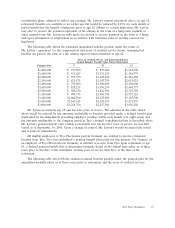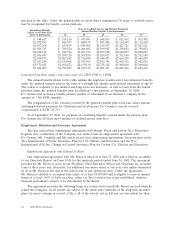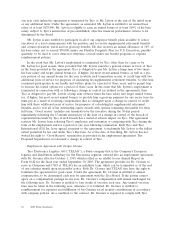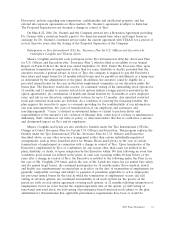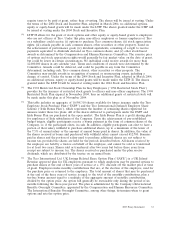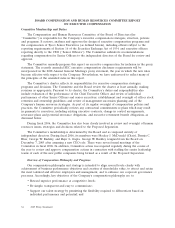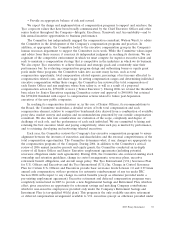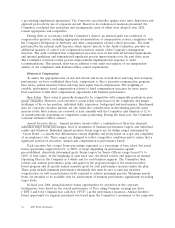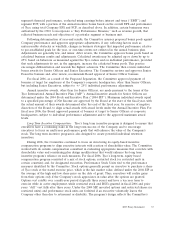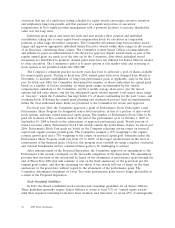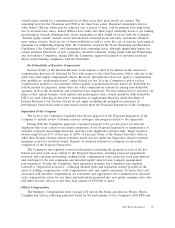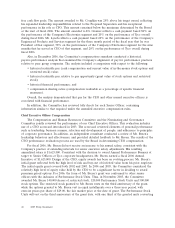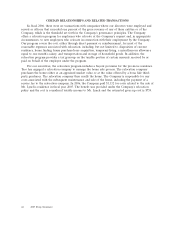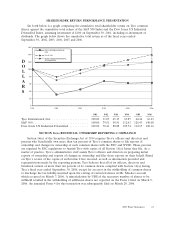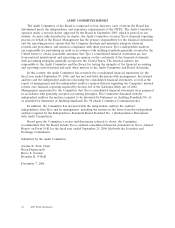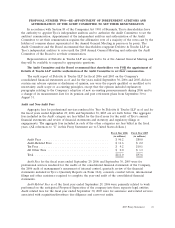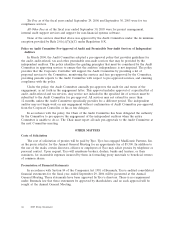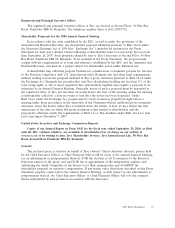ADT 2006 Annual Report Download - page 49
Download and view the complete annual report
Please find page 49 of the 2006 ADT annual report below. You can navigate through the pages in the report by either clicking on the pages listed below, or by using the keyword search tool below to find specific information within the annual report.
segment’s financial performance, evaluated using earnings before interest and taxes (‘‘EBIT’’) and
segment FCF, with a portion of the annual incentive bonus based on the overall EPS and performance
of Tyco, using total Company EPS and FCF, as described above. In addition, certain businesses were
authorized by the CEO to incorporate a ‘‘Key Performance Measure,’’ such as revenue growth, that
reflected business needs and objectives of a particular segment or business unit.
Following determination of year-end results, the Committee assesses proposed bonus pools against
Company performance and approves appropriate adjustments, if any, reflecting factors such as
unforeseeable obstacles or windfalls, changes in business strategies that impacted performance relative
to pre-established goals for the year, or one-time events not reflected in the annual business plan.
Adjustments are generally few, and minor. After review, the Committee approves bonus pools based on
calculated business results and adjustments. Calculated awards may be adjusted up or down by up to
25% based on behaviors as measured against the Tyco values and on individual performance, provided
that such adjustments do not, in the aggregate, increase the calculated bonus pools. This practice
encourages differentiation and rewards the highest achievers. The Committee then reviews individual
bonus awards for Senior Officers and Senior Executives. The Committee reviews and approves Senior
Executive bonuses and, after review, recommends Board approval of Senior Officer bonuses.
For fiscal 2006, as a result of the Proposed Separation, the Committee approved payment of
bonuses at target for employees at the Company’s corporate headquarters, other than Senior Officers,
but including Senior Executives, subject to +/- 25% individual performance adjustments.
Annual incentive awards, other than for Senior Officers, are made pursuant to the terms of the
Tyco International Annual Incentive Plan (‘‘AIP’’). Annual incentive awards for Senior Officers are
determined under the 2004 Stock and Incentive Plan (‘‘2004 SIP’’). Maximum individual awards equal
to a specified percentage of Net Income are approved by the Board at the start of the fiscal year, with
the actual amount of their awards determined after the end of the fiscal year, by exercise of negative
discretion of the Board, to align actual awards with award levels under the Annual Incentive Plan. For
fiscal year 2006, the Board approved payment of bonuses at target to Senior Officers at corporate
headquarters, subject to individual performance adjustment and to the approved maximum award
levels.
Long Term Incentive Compensation: Tyco’s long term incentive program is designed to ensure that
executives have a continuing stake in the long term success of the Company and to encourage
executives to focus on multi-year performance goals that will enhance the value of the Company’s
stock. The long term incentive program is also designed to create powerful individual retention
incentives.
During 2006, the Committee continued to focus on structuring its equity-based incentive
compensation programs to align executive interests with creation of shareholder value. The Committee
worked with its outside compensation consultant in evaluating appropriate measures that correlate with
shareholder value and considering plan design modifications that would enhance the long term
incentive program’s reliance on such measures. For fiscal 2006, Tyco’s long-term, equity based
compensation program consisted of a mix of stock options, restricted stock (or restricted units in
certain countries) and, for designated executives, Performance Stock Units tied to the performance
measures identified by the Committee. Stock options generally permit an executive to purchase a share
of Tyco stock at the stated exercise price, which is the fair market value, defined under the 2004 SIP as
the average of the high and low share price on the date of grant. Thus, executives will realize gains
from their options only if the Company’s stock appreciates in value after the options are granted.
Options vest ratably over a multi-year period (typically three years) and have a ten year term to
exercise while in active employment, while restricted stock and RSUs granted in fiscal 2006 and prior
years ‘‘cliff’’ vest fully after three years. Under the 2004 SIP, unvested options and restricted shares (or
restricted units) and performance stock units are forfeited if an executive voluntarily leaves the
Company other than due to retirement or disability. The program’s design reflects the Committee’s
2007 Proxy Statement 37


